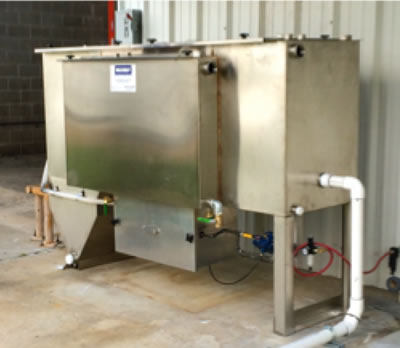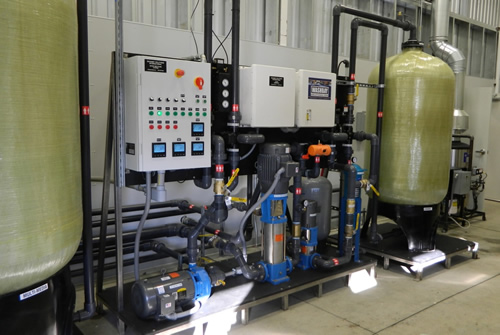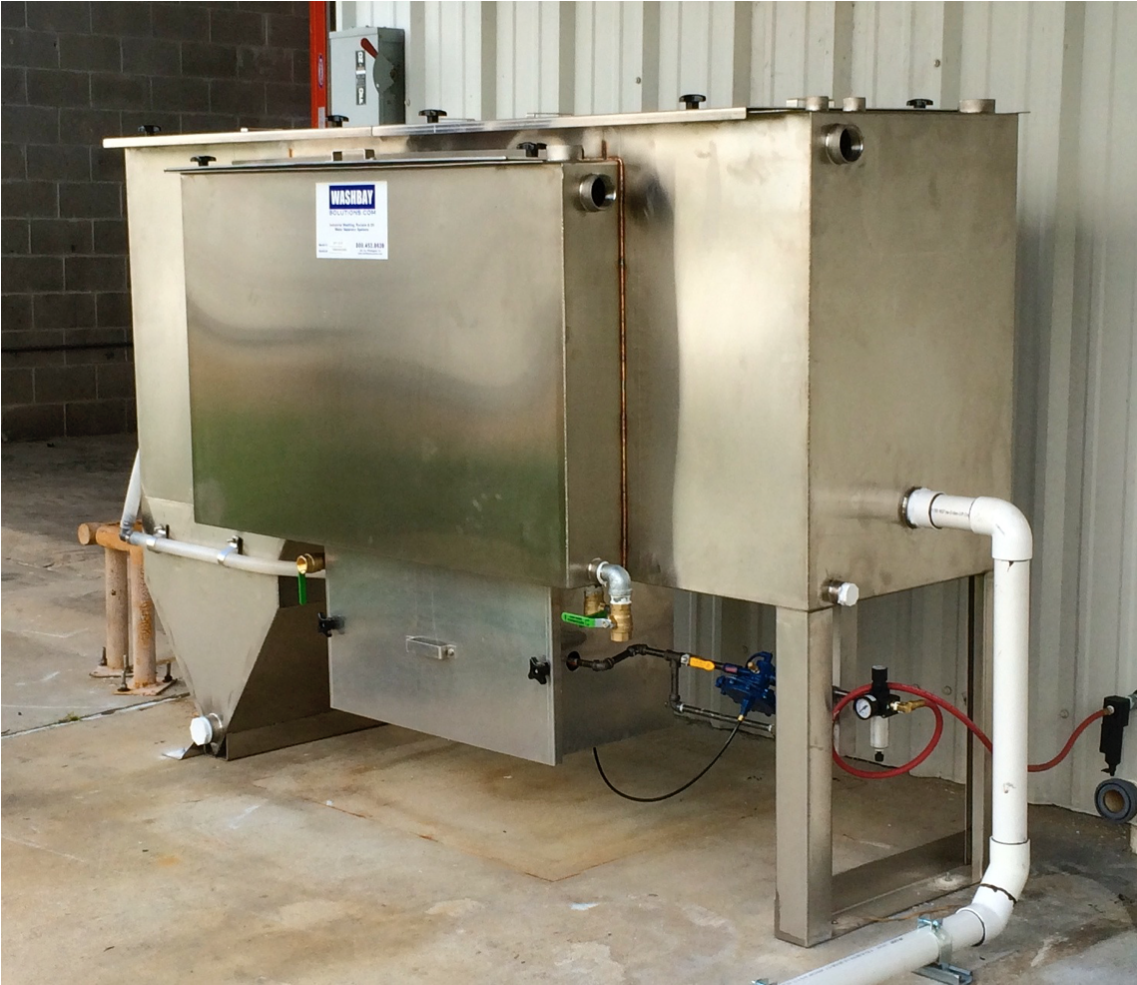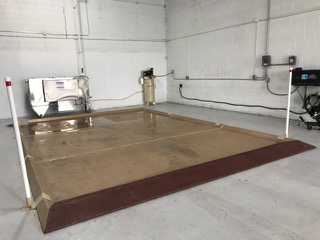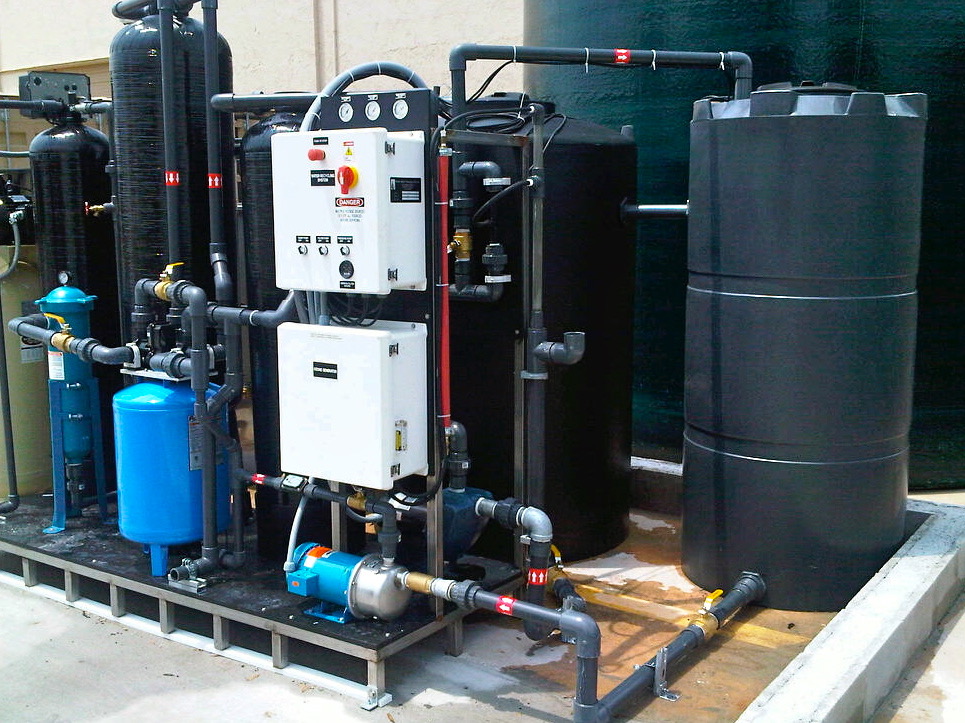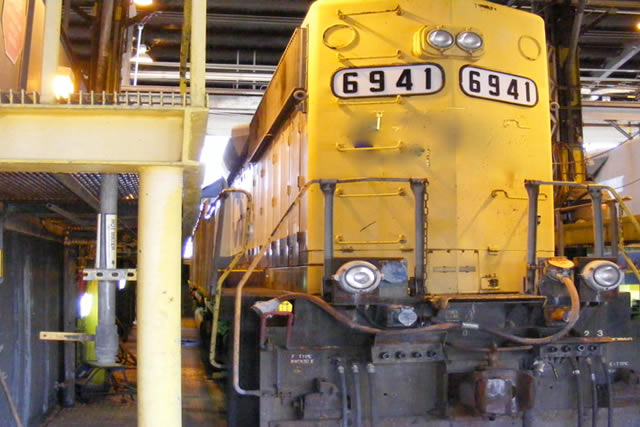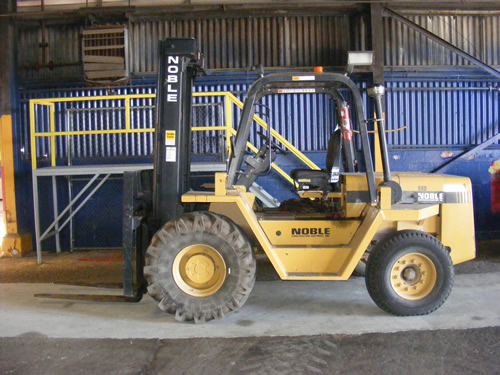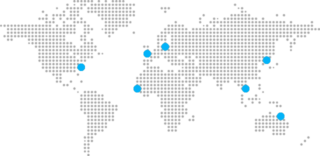The SPT Series Integrated Pretreatment Systems integrate an oil water separator with a clarifier to remove both floating oils and settlable solids.
Wash Water Treatment
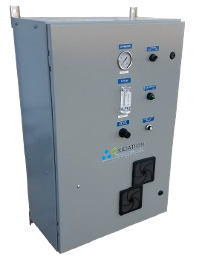
As an integral part of our closed loop wastewater treatment systems, our ozone generators eliminate odors and contaminates from the water and reduce operating costs by lowering freshwater usage and eliminating expensive chemical disinfectants and deodorants.
Depending on the application, our turnkey ozone generators house both an ozone generation cell and an oxygen concentrator or air dryer. Simply plug into electrical power and produce both oxygen and ozone from one unit. Compact, easy to use, and reliable, these systems will work in a variety of tough industrial applications.
Turnkey Ozone Generator with Air Dryer
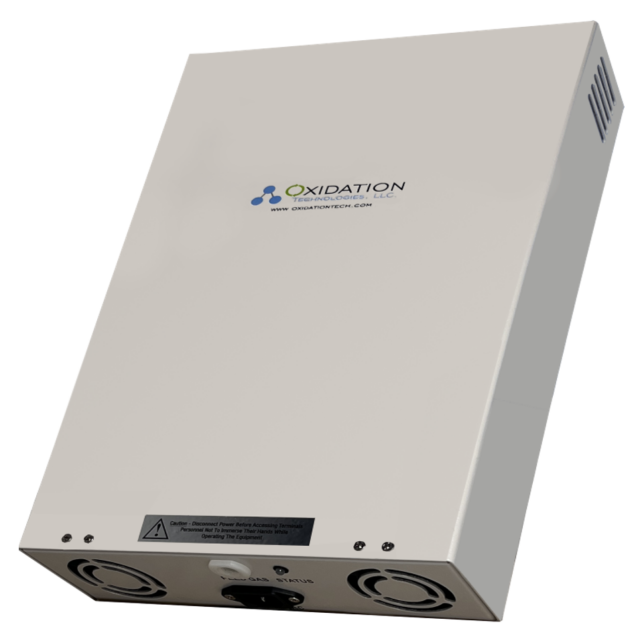
- Produces up to 10 g/hr of ozone @ 4 l/min of oxygen at over 3% by weight
- Integrated Air dryer provides 8 LPM Dry Air for ozone generation
- Efficient ozone generation – high concentration ozone
- Air cooled Ozone Generator – no cooling water necessary
- Visual Flow-meter
- Adjustable ozone output
- Easy to install and operate
- Attachments to integrate into water reclaim system
- Power required: 120 or 220 VAC
- Compressed air required: 4 CFM
- Air dryer can provide air dried to 40 deg F dew point for more efficient ozone generation
- Removeable corona cell for easy cleaning or repair
Turnkey Ozone Generator with Oxygen Concentrator
- Produces 10-150 g/hr of ozone from 4-30 l/min of oxygen
- Integrated Oxygen Concentrator produces 4-30 l/min of oxygen
- Efficient ozone generation – high concentration ozone
- Air cooled Ozone Generator – no cooling water necessary
- Visual Flow-meter
- Adjustable ozone output
- Easy to install and operate
- Attachments to integrate into water reclaim system
- Power required: 120 or 220 VAC
- Compressed air required: 4-12 CFM
Optional features
- Stainless steel enclosure
- Remote on/off controls for system integration
- Internal compressed air
- Ozone analyzer
Robustly designed and manufactured for commercial and industrial washing applications, our heavy-duty, multi-
stage, closed loop treatment systems treats the wash water so it can be used continuously without any discharge to
the sewer or surroundings. Many companies choose to haul this water away, but a more efficient way of removing
this cost is by recycling and reusing the water.
Stage 1 – Solids Settling
Most commercial washing operations produce a lot of solids so the first stage of our filtration process is the solids handling system. We help you develop site-specific solutions to eliminate as many solids as possible before the water goes to the next stage of filtration. Solutions include sumps, basins, trenches or screening systems that are custom-designed sized to fit your facility restrictions, washing processes and maintenance procedures.
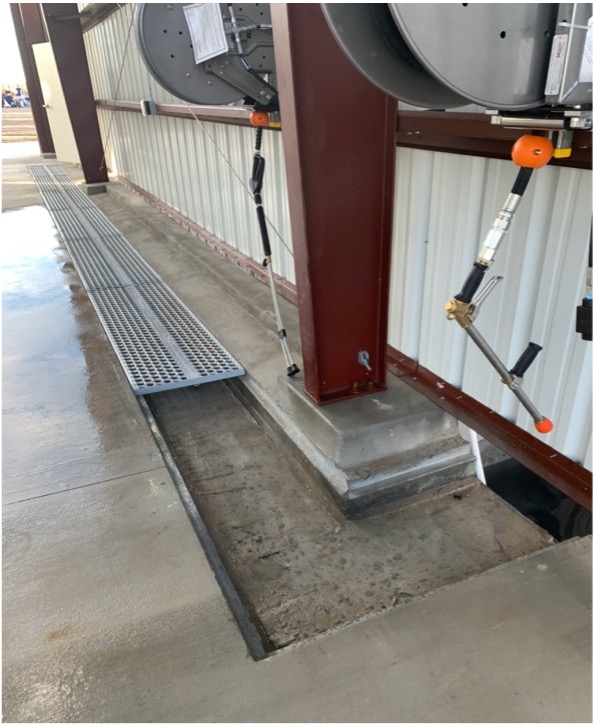 |
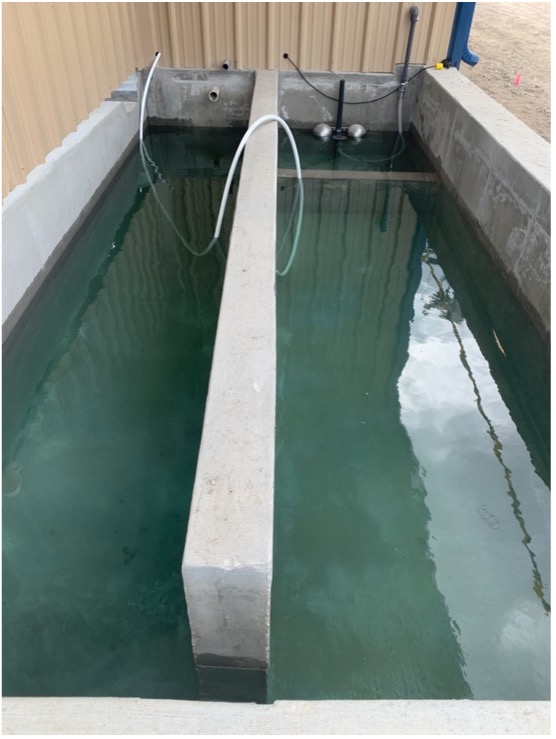 |
|
| Solids Handling Trench System | Solids Handling Basin System |
Stage 2 – Oils & Solids Separation
After the coarse solids settling, the water is processed through a multi-compartment stainless steel clarifier oil-water separator, which separates out smaller suspended solids, oil and water. In the first compartment, free oils float to the surface. In the second section, the stainless steel clarifying plates remove coarse amounts of oil and as much Total Suspended Solids (TSS) as possible. The angles of the non-clogging plates are 55° which allows solids to slide down the plates into the solids hopper, where they can easily be pumped out. Next, the water goes through our coalescing media which removes essentially 100% of all free and dispersed non-emulsified oils so the FOG effluent concentration can be as low as 5 ppm.
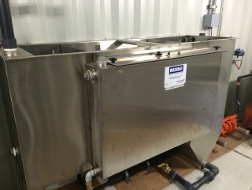 |
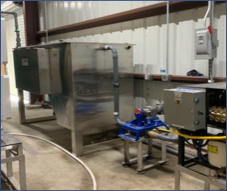 |
|
| SPT-10 Clarifier Oil Water Separator | SPT-30 Clarifier Separator with Pump & Control |
Stage 3 – Water Filtration, Odor Reduction & Polishing
After the clarifier oil-water separator, the water is pumped though several filtration steps including multi-media (sand, gravel, anthracite), blended activated carbon, polishing filter, and corona discharge ozone. These filters reduce odors and any contaminants to fewer than 10 microns in size, including emulsified oils, waxes, and other volatile organic compounds. Media, carbon, ozone and water storage volumes are typically customized to meet your particular application.
Closed Loop System Features
- Non-Ferrous Construction – Stainless Steel, PVC, Fiberglass
- Fully-Automatic, pre-wired
- Multi-Stage / Multi-Pass Filtration
- Clarifier Separator System
- Stainless Steel Clarifier Oil/Water Separator with 55° Hopper
- Advanced European coalescing media designed to remove oil droplets greater than 20 microns
- Electric or Air Diaphragm pump with controller
- Closed Loop Filtration System
- Automated Self-Cleaning Multi-Media and Carbon Fiberglass Filter Tanks
- Heavy-duty, high efficiency Re-Circulation Pumps
- Heavy-duty high efficiency Re-Pressurization Pumps
- Transfer pump to pump water from clarifier separator to system
- Heavy-duty Ozone System to control odors (up to 32 gms per hour)
- (2) Poly water storage tanks – UV Protected
- Sensors and interconnecting Schedule 80 plumbing
- NEMA-4X control panel
- PLC controller for automatic back wash operations
- All components mounted on heavy-duty stainless steel skid
Depending on the location, many options are available to maximize the efficiency of the wastewater treatment system including:
Optional Features
-
- Additional water storage tanks
- Bag filters
- Transportable equipment rooms
- Rain Diverter Systems
- pH control system
- TDS monitoring system
- Electric disk skimmers
- Automatic sludge dump systems
- Corrosion protection packages for high salt or corrosive applications
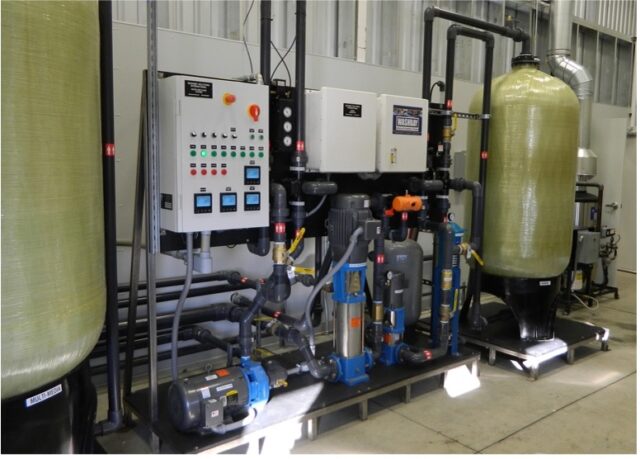 |
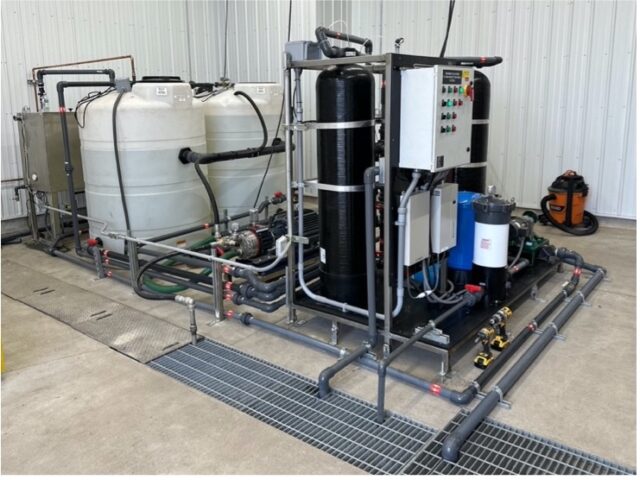 |
|
| CT-65 – 65 GPM Closed Loop Treatment System | CT-10 – 10 GPM Closed Loop Treatment System with Tanks & Separator |
Typical Closed Loop System Flow Process
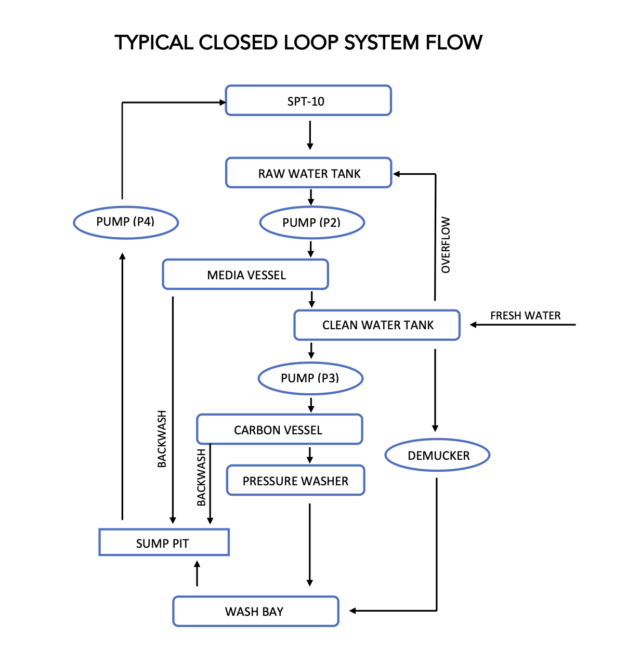
TYPICAL CLOSED LOOP SYSTEM SPECIFICATIONS
| MODEL | CT-10/10 | CT-35/20 | CT-65/50 | CT-100* |
| DESIGN FLOW RATE, GPM | 1-10 | 1-25 | 10-55 | 30-100 |
| COALESCING PLATE AREA, SF | 41 | 124 | 211 | 400 |
| COALESCING MEDIA, CF | 4 | 8 | 24 | 48 |
| CLARIFIER SEPARATOR SIZE, FT (WxLxH) | 3 x 7 x 5 | 3.5 x 8 x 6 | 4 x 10 x 6 | 5 x 11 x 7 |
| NON-EMUSIFYING INFLUENT PUMP, GPM MAX | 20 | 50 | 75 | 125 |
| MULTI-MEDIA, LBS | 300-500 | 500-1000 | 2500-2600 | 3700-4200 |
| ACTIVATED CARBON, CF | 4-15 | 10-40 | 20-40 | 40 |
| POLISHING FILTER, SET | 1 | 1 | 1 | 1 |
| RECLAIM RE-CIRCULATION PUMP, HP | 1.5 | 1.5 | 3 | 5 |
| RECLAIM RE-PRESSURIZATION PUMP, HP | 1 | 3 | 5 | 7.5 |
| DIRTY WATER STORAGE VOLUME, GAL | 500-750 | 500-1000 | 750-1500 | 1000-2500 |
| CLEAN WATER STORAGE VOLUME, GAL | 500-750 | 500-1000 | 750-1500 | 1000-2500 |
| OZONE SYSTEM, GRAMS/HR | 8-16 | 8-32 | 16-32 | 32 |
| RECLAIM CONTROL SYSTEM | PLC, Automatic, Manual or Off | |||
| RECLAIM PUMP FRAME SIZE, FT (WxLxH) (TANKS ADDITIONAL) |
4 x 6 x 6.5 | 4 x 8 x 8 | ||
| POWER REQUIREMENTS | 208 / 240 V 1 ph or 208 / 240 / 480 V 3 ph | |||
* LARGER CAPACITY SYSTEMS (200-1500 GPM) ARE AVAILABLE
APPLICATIONS:
- Commercial Trucking
- Locomotive
- Mining
- Marine
- Forklift
- Oil and Gas Drilling
FABRICATION: The clarifier/separator is a special purpose prefabricated inclined plate and parallel corrugated plate, rectangular, gravity displacement, type unit. The clarifier/separator shall be comprised of a tank containing an inlet compartment, sludge chamber, a separation compartment, and clean water outlet chamber.
TANK: The tank shall be a single wall construction of 11 gauge stainless steel conforming to ASTM A240, type 304 stainless steel. Welding will be in accordance with AWS D1.1 to provide a watertight tank that will not warp or deform under load.
PIPE CONNECTIONS: All pipe connections 3” and smaller are FNPT couplings. All connections 4“ and larger are flat face flanges with ANSI 150 pound standard bolt circle.
LIFTING LUGS: The tank shall be provided with properly sized lifting lugs for handling and installation.
COVERS: The tank will be provided with vapor tight covers for vapor control. Gas vents and suitable access openings to each compartment will be provided. The covers shall be constructed of marine grade aluminum and will be fastened in place. A gasket shall be provided for vapor tightness. 3/8-16 bolts and threaded knobs will be provided for cover attachment.
INLET COMPARTMENT & INCLINED PLATES: The inlet chamber shall be comprised of a non-clog diffuser to distribute the flow across the width of the chamber. The inlet compartment shall be of sufficient volume to effectively reduce influent suspended solids, dissipate energy and begin separation. The inclined plates will sit elevated on top of a sludge chamber. As the water moves upwards the suspended particles have their upwards velocity interrupted by the inclined plates. These particles drop down and slide down the inclined plate and join larger previously settled particles in sludge hopper. The sludge compartment will be provided to retain settleable solids.
SEPARATION CHAMBER: The oil separation chamber shall contain HD Q-PAC Coalescing Media containing a minimum of 132 square feet per cubic foot of effective coalescing surface area. The medias needle like elements (plates) shall be at 90 degrees to the horizontal or longitudinal axis of the separator. Spacing between these elements shall be spaced 3/16” apart for the removal of a minimum of 99.9% of free droplets 20 micron in size or greater. The elements are positioned to create an angle of repose of 90 degrees to facilitate the removal of solids that may tend to build up on the coalescing surfaces, which would increase velocities to the point of discharging an unacceptable effluent.
Laminar flow with a Reynolds Number of less than 500 at a maximum designed flow rate shall be maintained throughout the separator packed bed including entrance and exit so as to prevent re-entrainment of oils with water. Flow through the polypropylene coalescing media shall be crossflow perpendicular to the vertical media elements such that all 132 square feet/cubic foot of coalescing media is available for contact with the coalescing surfaces.
None of the coalescing media surfaces shall be pointing upward so as not to be available for contact with the cross-flowing oily water. The media shall have a minimum of 87% void volume to facilitate sludge and dirt particles as they fall off the vertical elements and settle in the sludge compartment. The media when installed in crossflow OWS shall meet US EPA Method 413.2 and also European Standard 858-1.
BAFFLES: The tank shall be provided with an oil retention & underflow weir, and overflow weir. The underflow weir will be positioned to prevent re-suspension of settled solids.
SLUDGE CHAMBER: The sludge chamber shall be located prior to the coalescing compartment for the settling of any solids. It shall also prevent any solids from entering the clean water chamber.
OIL SKIMMER: The clarifier compartment and the oil separation compartment will be provided with rotatable pipe skimmers for gravity decanting of the separated oil to a product storage tank.
CLEAN WATER CHAMBER: The tank will be provided with a clean water chamber which allows the water to leave the separator by pumped flow through the clean water outlet port.
VENTS: 2″ vents will be provided for vent piping to atmosphere.
PUMP TRANSFER SYSTEM: The system is provided with either an electric powered or air-powered diaphragm transfer pump. Electric motor can be 110V/240V/480V. Pump is installed near the SPT system. A screen should be placed on the pump intake to reduce the amount of solids entering the system.
PUMP CONTROL PANEL: The control panel for the pump will be housed in a NEMA-4X enclosure. The controls may include a Main Disconnect Switch, an Emergency Stop switch, a Manual/off/auto pump switch, 24-volt control relay, Circuit Breaker, motor contactor and overload, and Green run, red fault panel lights. It may be UL certified, if needed.
OPTIONAL POLISHING PACK: A final water polishing pack with a stainless steel flow dissipator plate and oil absorbent bags may be provided with the system if local municipalities have sewer effluent requirements.
OPTIONAL OZONE SYSTEM: The system may be provided with an ozone generator to reduce odors.
SPT Specifications Size Chart
| SPT-10 | SPT-20 | SPT-30 | SPT-50 | SPT-75 | SPT-100 | |
| Flow Rate | 1-10 GPM | 1-20 GPM | 1-30 GPM | 1-50 GPM | 1-75 GPM | 1-100 GPM |
| Tank Capacity | 300 Gal | 652 Gal | 645 Gal | 968 Gal | 1419 Gal | 1931 Gal |
| Sludge Volume | 27 Gal | 27 Gal | 45 Gal | 85 Gal | 85 Gal | 85 Gal |
| Ozone Generation | Optional | Optional | Optional | Optional | Optional | Optional |
| Product Tank | 40 Gal | 40 Gal | 40 Gal | 75 Gal | 75 Gal | 75 Gal |
| Polishing Pack | Optional | Optional | Optional | Optional | Optional | Optional |
| Approx. dimensions, FT | 3’W x 8’L x 5’H | 4’W x 8.5’L x 6’H | 4’W x 9’L x 6’H | 4’W x 9.75’L x 6’H | 4.5’W x 10’L x 7’H | 5.3’W x 10.5’L x 7.3’H |
| Construction | Stainless Steel | Stainless Steel | Stainless Steel | Stainless Steel | Stainless Steel | Stainless Steel |
In some applications with extensive contamination, a simple oil water separator is simply not enough to treat the water prior to sewer discharge. Our heavy-duty MM-Series treatment systems treat wash water in multiple stages so it can be safely discharged to the sewer or, in many cases, the surroundings.
Stage 1 – Solids Settling
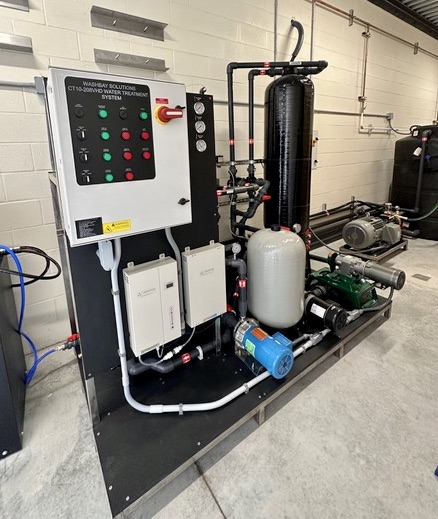
Almost all commercial washing operations produce some solids so the first stage of our filtration process is the solids handling system. We help you develop site-specific solutions to eliminate as many solids as possible before running the water through to the next stage of filtration. Solutions include custom-designed sumps, basins, trenches or screening systems.
Stage 2 – Oils & Solids Separation
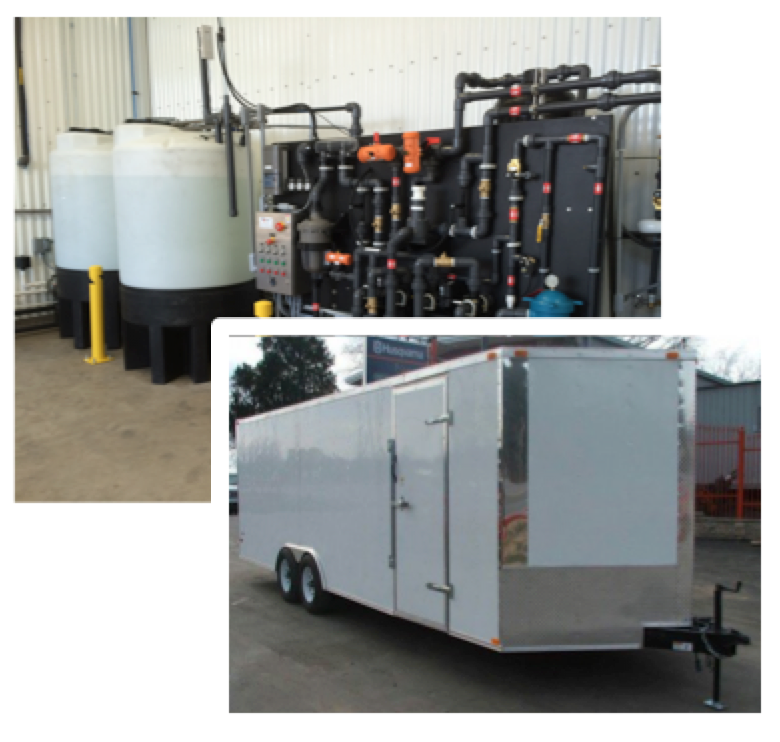
After the coarse solids settling, the water is processed through either a multi-compartment stainless steel oil water separator or a stainless steel clarifier oil-water separator, which separates out smaller suspended solids, oil and water. In the first compartment of the clarifier oil water separator, free oils float to the surface. In the second section, the stainless steel clarifying plates remove coarse amounts of oil from the waste stream and remove as much Total Suspended Solids (TSS) as possible. The angles of the non-clogging plates are 55° which will allow any solids to slide down the plates into the solids hopper, where they can easily be pumped out. Finally, the coalescing media removes essentially 100% of all free and dispersed non-emulsified oils so the FOG effluent concentration can be as low as 5 ppm.
Stage 3 – Water Filtration & Polishing
After the clarifier oil-water separator, the water is pumped though a multi-media (sand, gravel, anthracite) filter and then safely discharged to the sewer or surroundings. Processed water passing through the system will be free of substantially all emulsified oils, waxes and other volatile organic compounds with only limited soaps and detergents remaining in the treated water. If needed, a blended activated carbon or a carbon/clay mixture tailored to a particular waste stream can be added as an optional polishing filter.
System Features
- Non-Ferrous Construction – Stainless Steel, PVC
- Fully-Automatic, pre-wired
- Clarifier Separator System
- Stainless Steel Clarifier Oil/Water Separator with 55° Hopper
- Advanced European coalescing media designed to remove oil droplets greater than 20 microns
- Electric or Air Diaphragm pump with controller
- Discharge Filtration System
- Automated Self-Cleaning Multi-Media and/or Clay/Carbon Fiberglass Filter Tank
- Heavy-duty, high efficiency Pump
- Sensors and interconnecting Schedule 80 plumbing
- NEMA-4X control panel
- PLC controller for automatic back wash operations
- All components mounted on heavy-duty stainless steel skid
Depending on the location, many options are available to maximize the efficiency of the wastewater treatment system including:
Optional Features
- Can be configured with existing equipment
- SCADA and remote monitoring UL/CSA Listing
- Transportable equipment rooms
- Rain Diverter Systems
- Chemical/Acid/Salinity Resistant Pumps & Components
- pH control system
TYPICAL MM-SERIES SYSTEM SPECIFICATIONS
|
MODEL |
MM-10/10 |
MM-35/20 |
MM-65/50 |
MM-100* |
|
DESIGN FLOW RATE, GPM |
1-10 |
1-25 |
10-55 |
30-100 |
|
COALESCING PLATE AREA, SF |
41 |
124 |
211 |
400 |
|
COALESCING MEDIA, CF |
4 |
8 |
24 |
48 |
|
CLARIFIER SEPARATOR SIZE, FT (WxLxH) |
3 x 7 x 5 |
3.5 x 8 x 6 |
4 x 10 x 6 |
5 x 11 x 7 |
|
NON-EMUSIFYING INFLUENT PUMP, GPM MAX |
20 |
50 |
75 |
125 |
|
MULTI-MEDIA, LBS |
300-500 |
500-1000 |
2500-2600 |
3700-4200 |
|
OPTIONAL POLISHING CLAY/CARBON, CF |
4-15 |
10-40 |
20-40 |
40 |
|
FILTER PUMP, HP |
1.5 |
2 |
3 |
5 |
|
DIRTY WATER STORAGE VOLUME, GAL |
500-750 |
500-1000 |
750-1000 |
1000-1500 |
|
CONTROL SYSTEM |
PLC, Automatic, Manual or Off |
|||
|
PUMP FRAME SIZE, FT (WxLxH) |
3 x 6 x 6.5 |
3 x 8 x 8 |
||
|
POWER REQUIREMENTS |
208 / 240 V 1 ph or 208 / 240 / 480 V 3 ph |
|||
* LARGER CAPACITY SYSTEMS (200-1500 GPM) ARE AVAILABLE
APPLICATIONS:
- Commercial Trucking
- Locomotive
- Mining
- Marine
- Forklift
- Oil and Gas Drilling
Robustly designed for range of industrial applications from oilfield pipe washing to large equipment washing to large hand tools, our Solids Settling Systems with Geo Bags are designed to help control costs associated with solids removal from wash bay sumps.
They can be constructed in a range of sizes, configurations and materials, depending on your application. Main components include a multi-compartment sump, an air driven solids handling pump, a control system, geo de-watering bags, and optional holders.
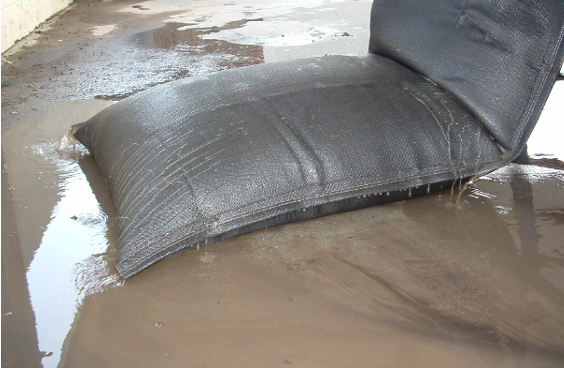
Benefits
- Built to any size and configuration
- Heavy-duty construction
- Range of porosities available
- Cost effective
- Easy to install and move
- Impervious to non-petroleum
System Components
Geo Bags – Placed in the sump or securely fastened to the end of a discharge pipe or hose, the bag slows down the flow of the incoming water, allowing the suspended solids to remain in the bag. Over time, the bag releases the water. Once the sediment-laden bag is de-watered, it can be picked up by a front-end loader and easily disposed of according to local enforcement agency regulations. The fabric is comprised of a heavy non-woven fabric and double chain stitched for extra security. Non-woven geo-textiles are approved by many local, state and federal agencies, including the Federal Highway Administration, U.S. Army Corps of Engineers, the Environmental Protection Agency and AASHTO.
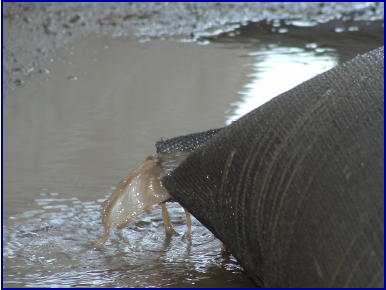
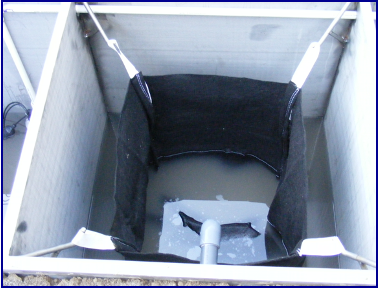
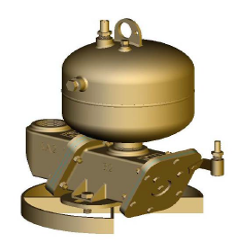
Pump & Control System – We use heavy-duty, solids handling, air driven pumps that can be fully or partially submerged. These pumps handle debris ranging from stringy to abrasive up to 2” diameter including slurries. The pump and control systems come with a variety of valves, seats, and control panel options that will be engineered to your particular application.
Sump System – The sump is an integral part of the solids handling and separation system. They can be built in stainless steel, aluminum or concrete, with multiple compartments, weirs or screens. Sump sizes are engineered for the washing application and water treatment system. Depending on the application and location, they can be placed above ground or buried.

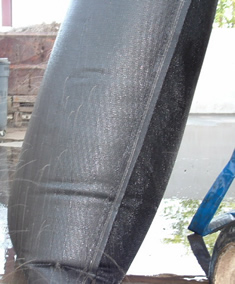
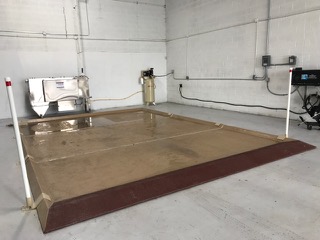
Problem: A car dealer moving into a new facility with a limited time lease. The property owner did not want them to cut concrete or substantially alter the property but the dealer needed to be able to wash dozens of cars per week onsite, contain the water and discharge it properly to the sewer.
Solution: For a complete wash system, we recommended installing a SPT-10 Clarifier Oil Water Separator System, a cold water pressure washer with a portable hose reel, and a portable wash containment pad. This allows them to wash as many cars as possible without any major modifications to the property. They will also be able to move the entire system to a new facility at the end of their lease. With their input, we helped them layout the system to maximize their space.
After installation of the pad, however, they noticed the concrete floor slope much slighter than originally thought and that the wash water was not moving off the pad well. This flat slope left his staff working in standing water and the SPT-10 not being able to process the wash water properly.
To improve this drainage issue, our staff developed a low cost under layer for the wash pad which created a slight slope for the water. We then installed this under layer and re-piped the in-take piping for the SPT-10 so the wash water flows freely. The general manager of the facility is very pleased with our systems and service.
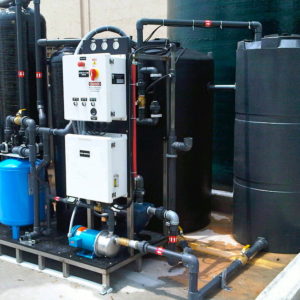
The MM-Series Water Treatment System is a complete self-contained, extremely efficient filtration system consisting of a fully automated multi-media filter and carbon polishing filter.
Processed water is initially filtered to contain no particles greater than 40 microns in size. It is then filtered further so that it is free of substantially all emulsified oils, waxes and other volatile organic compounds. Limited soaps and detergents may remain in the treated water. Processed water shall be acceptable to discharge to the sewer. The carbon or carbon clay mixture can be tailored to meet specific local effluent requirements and adjusted based on the testing results.
The filters are programmed to automatically backwash back to the wash bay using domestic water. It is designed to be simple to operate but very effective in its ability to meet today’s environmental requirements.
STANDARD FEATURES:
- Automated Self-Cleaning Multi-Media Deep Bed Filter
- Carbon polishing filter
- Tailored media to meet compliance standards
- High Efficiency Self-priming Filter Pump
- Automatic or Manual Control System
- PLC controller for back wash operations and valve actuation
- Stainless Steel frame
- Skid-mounted for easy portability
- All controls, and level switches
- Low operating and maintenance costs
OPTIONAL FEATURES:
- Pre-filtration for heavy solids removal
- Ozone system for odor control
- PLC control with remote monitoring capability
- Oil content monitor and alarm
- pH control system
- U.L. Listing
- Can be installed in portable equipment room or trailer
MM-SERIES SYSTEM SPECIFICATIONS
| MODEL: | MM-5 | MM-10 | MM-35 | MM-65 | MM-100 |
|---|---|---|---|---|---|
| FLOW RATE | 5 gpm | 10 gpm | 35 gpm | 65 gpm | 100 gpm |
| FILTER PUMP | 3/4 hp | 1 hp | 2 hp | 3 hp | 5 hp |
| INLET | 2” | 2” | 2” | 2” | 2” |
| OUTLET | 1” | 1” | 2” | 2” | 2” |
| WEIGHT (lbs.) | 450 | 500 | 600 | 700 | 800 |
| CONTROL SYSTEM | Automatic or Manual Control | ||||
| FILTRATION | Multi-Media Deep Bed Filter | ||||
| WATER POLISHING | Carbon Deep Bed Filter | ||||
| UTILITIES | 3 phase 240/480/575 V 60 Hz or single phase 230V | ||||
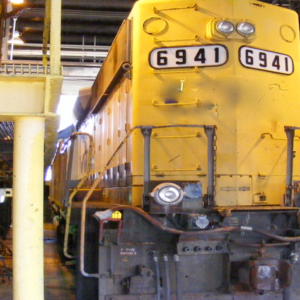
Rail is by far one of the most efficient means of transportation. It is estimated that one train can move a ton of freight almost 500 miles on a single gallon of fuel. Today, Rail Companies are aggressively embracing environmental initiatives by investing in new technologies that further reduce their carbon footprint, energy use, and water consumption.
We can help rail companies keep the trains clean and in good working order AND help them reach their environmental goals. Engineered and manufactured for the locomotive industry, our Rail & Locomotive (RL Series) Systems are heavy-duty, multi-stage wash water reclaim systems which can be combined with our single or multi-stage wash and rinse arches for a complete wash system that uses a fraction of the water of other wash systems on the market.
In the first stage our RL Systems, the water is processed through a stainless steel clarifier oil water separator which removes most suspended solids (TSS), essentially all settleable solids and all free and dispersed non-emulsified oils from the waste stream.
After the clarifier separator, the water is further processed for re-use by going through an extremely efficient filtration process utilizing fully automated solids filtration and a proprietary blended activated carbon (GAC) polishing filtration. Processed water passing through the system will be free of particles greater than 10 microns in size, substantially all emulsified oils, waxes and other volatile organic compounds.
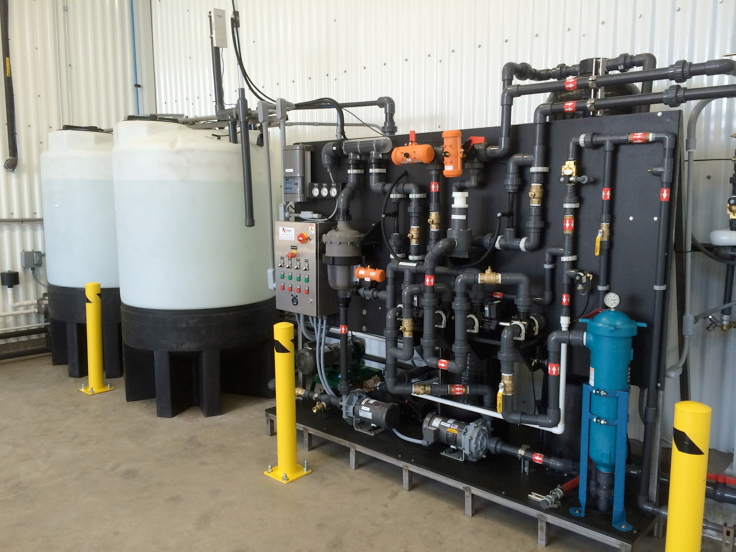
RL SERIES STANDARD FEATURES:
- High-Efficiency Pumps
- Corona Discharge Ozonation System
- Solids Handling & Separation
- TSS & FOG Reduction
- Multi-Stage / Multi-Pass Filtration
- Pressurized Blended Carbon Polishing Filter
- Auto-Backwashing Filters
- Stainless Steel Construction
- NEMA 4X Control Panel with PLC controller
Depending on the location, many options are available to maximize the efficiency of the wastewater treatment system including:
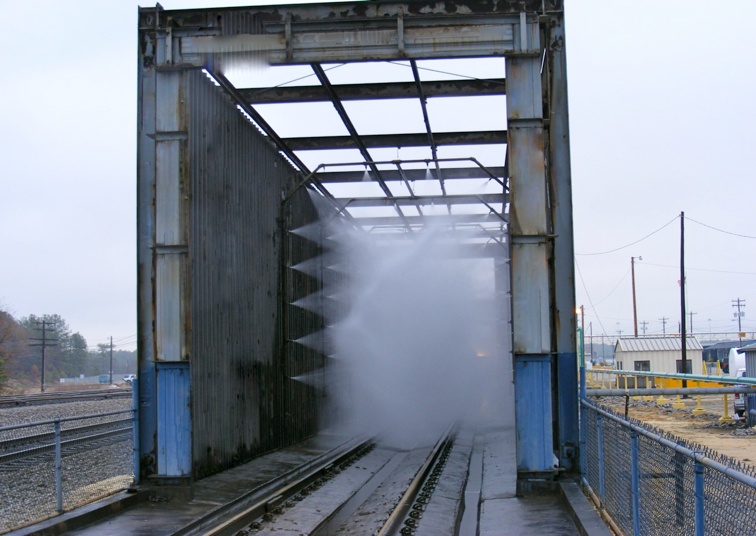
OPTIONAL FEATURES:
- Wash & Rinse Arches
- Remote controls & switches
- SCADA and remote monitoring
- UL/CSA Listing
- Transportable equipment rooms
- Rain Diverter Systems
- Chemical/Acid/Salinity Resistant Pumps & Components
- ORP / pH control system
RL SERIES SYSTEM SPECIFICATIONS
| MODEL | RL-10/10 | RL-30/20 | RL-60/50 | RL-100 | RL-200* | |
|---|---|---|---|---|---|---|
| FLOW RATE, GPM | 1-10 | 1-30 | 10-60 | 30-100 | 60-200 | |
| COALESCING PLATE AREA, SF | 41 | 124 | 211 | 400 | 600 | |
| COALESCING MEDIA, CF | 4 | 8 | 24 | 48 | 96 | |
| APPROX. CLARIFIER SEPARATOR SIZE, FT (WxLxH) | 3 x 7 x 5 | 3.5 x 8 x 6 | 4 x 10 x 6 | 5 x 11 x 7 | 7 x 13 x 9 | |
| RECLAIM RE-CIRCULATION PUMP, HP | 1.5 | 3 | 3 | 5 | 5 | |
| RECLAIM RE-PRESSURIZATION PUMP, HP | 1 | 3 | 5 | 7.5 | 10 | |
| OZONE SYSTEM | Up to 32 grams of ozone per hour | |||||
| RECLAIM CONTROL SYSTEM | PLC, Automatic, Manual or Off | |||||
| RECLAIM PUMP FRAME SIZE, FT (WxL) (TANKS ADDITIONAL) |
3 X 6 | 3 x 8 | ||||
| POWER REQUIREMENTS | 208 / 240 V 1 ph or 208 / 240 / 480 V 3 ph | |||||
| * LARGER CAPACITY SYSTEMS (500-1500 GPM) ARE AVAILABLE | ||||||
Industrial forklifts are used in a variety of places including construction sites, shipyards, mines and drilling sites. They are invaluable in that they can unload pallets of materials, steel girders and pipes and other products from the delivery trucks and carry them to parts of the work sites that are not accessible to other vehicles. Larger, heavy-duty forklifts can also transport large containers from delivery trucks to dockside storage areas, and then to the ships. Due to the working conditions and locations, forklifts will often get extremely dirty. After washing, the wash water generated will be full of grease and oil.
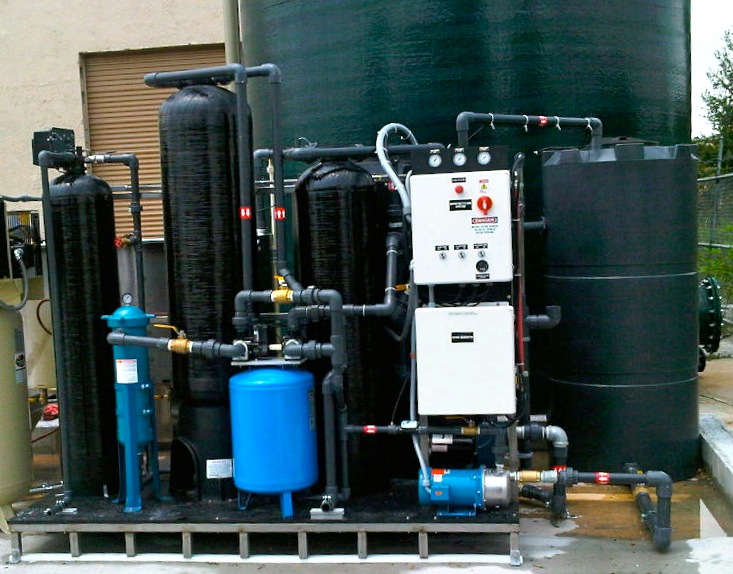
Our Fork Lift (FL Series) Water Treatment Systems are heavy-duty, multi-stage reclaim and discharge systems. Depending on the usage, a certain amount of solids will be generated by the washing process. To handle the solids, our engineers will develop a site-specific solids removal system which could include sumps, trenches, screens, debris baskets and skimmers.
After many of the solids are removed in the first stage, the water will then be processed through a stainless steel clarifier oil water separator which removes most suspended solids (TSS), essentially all settleable solids and all free and dispersed non-emulsified oils from the waste stream.
After the clarifier separator, the water can either be discharged or further processed for re-use. If the water needs to be re-used, the water then goes through an extremely efficient filtration process utilizing fully automated solids filtration and a proprietary blended activated carbon (GAC) polishing filtration, and a corona discharge ozone generator to prevent odors. Processed water passing through the system will be free of particles greater than 10 microns in size, substantially all emulsified oils, waxes and other volatile organic compounds.
FL SERIES STANDARD FEATURES:
- Stainless Steel Construction
- High-Efficiency Pumps
- Corona Discharge Ozonation System
- Solids Handling & Separation
- TSS & FOG Reduction
- Multi-Stage / Multi-Pass Filtration
- Pressurized Blended Carbon Polishing Filter
- Auto-Backwashing Filters
- NEMA 4X Control Panel with PLC controller
Depending on the location, many options are available to maximize the efficiency of the wastewater treatment system including:
OPTIONAL FEATURES:
- Can be configured with existing equipment
- SCADA and remote monitoring
- UL/CSA Listing
- Transportable equipment rooms
- Rain Diverter Systems – if wash pads are uncovered
- Rain Water Harvesting Systems
- Chemical/Acid/Salinity Resistant Pumps & Components
- ORP / pH control system
FL SERIES SYSTEM SPECIFICATIONS
| MODEL | FL-10/10 | FL-30/20 | FL-60/50 | FL-100* | |
|---|---|---|---|---|---|
| FLOW RATE, GPM | 1-10 | 1-30 | 10-60 | 30-100 | |
| COALESCING PLATE AREA, SF | 41 | 124 | 211 | 400 | |
| COALESCING MEDIA, CF | 4 | 8 | 24 | 48 | |
| APPROX. CLARIFIER SEPARATOR SIZE, FT (WxLxH) | 3 x 7 x 5 | 3.5 x 8 x 6 | 4 x 10 x 6 | 5 x 11 x 7 | |
| RECLAIM RE-CIRCULATION PUMP, HP | 1.5 | 3 | 3 | 5 | |
| RECLAIM RE-PRESSURIZATION PUMP, HP | 1 | 3 | 5 | 7.5 | |
| OZONE SYSTEM | Up to 32 grams of ozone per hour | ||||
| RECLAIM CONTROL SYSTEM | PLC, Automatic, Manual or Off | ||||
| RECLAIM PUMP FRAME SIZE, FT (WxL) (TANKS ADDITIONAL) |
3 X 6 | 3 x 8 | |||
| POWER REQUIREMENTS | 208 / 240 V 1 ph or 208 / 240 / 480 V 3 ph | ||||
| * LARGER CAPACITY SYSTEMS ARE AVAILABLE | |||||
Headquarters
WashBay Solutions International

